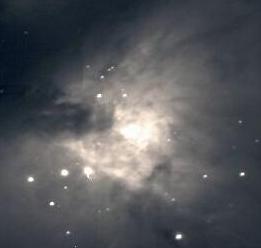 To the LEFT is a typical picture of the Young Star Forming Region
known as Orion Nebula, which makes up the tip of his sword.
The nebula (glow) is due to hydrogen, ionized by the hot
central stars.
To the LEFT is a typical picture of the Young Star Forming Region
known as Orion Nebula, which makes up the tip of his sword.
The nebula (glow) is due to hydrogen, ionized by the hot
central stars. To the RIGHT is an HST (Hubble Space Telescope) high resolution image of the central portion, revealing several very bright, massive stars which have recently formed (shown in Blue). The most luminous stars is an O6 V (very hot, very massive). All around there is left over gas and dust, some of it still in the process of forming new stars. Note the bright yellow `tadpole' looking sources. They have been termed `Proplyds' (short for proto-planetary disks). Notice how they all face the the O6 V star. It is a strong source of UV radiation. |

|
|
Upon closer inspection of these proplyds, we see they are
dense condensations of proto-stars with proto-planetary systems.
If they do form a star, it will be something quite small, smaller even than the Sun. Proplyd #5 looks very much to have a bright star at the center, with a ring of `proto-planetary' material around it. This is likely the origins of a distant solar system of planets. |

|